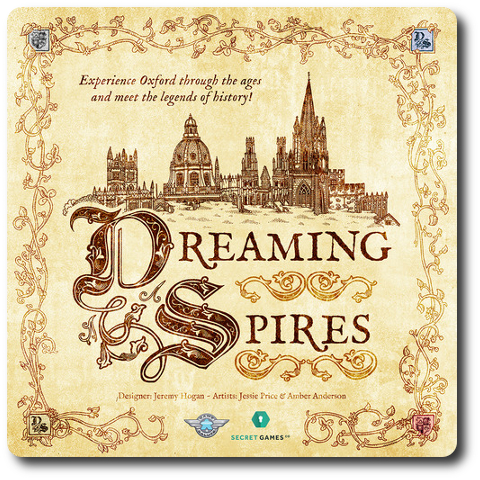
The Basics:
- For ages 10 and up
- For 3 to 5 players
- Approximately 90 minutes to complete
Geek Skills:
- Counting & Math
- Logical & Critical Decision Making
- Reading
- Pattern/Color Matching
- Strategy & Tactics
- Auctioning & Bidding
Learning Curve:
- Child – Moderate
- Adult – Easy
Theme & Narrative:
- Build a college to enlighten the world!
Endorsements:
- Gamer Geek approved!
- Parent Geek approved!
- Child Geek mixed!
Overview
Socrates said, “The only good is knowledge and the only evil is ignorance.” In the spirit of Socrates and his passion to challenge people’s thinking (which ultimately lead to his death), schools, colleges, and universities have been formed. Students of all ages and from all walks of life have met under roofs of thatch, mud, wood, metal, and marble for centuries to learn. You are now tasked to create a college that will house the greatest scholars so young minds might be challenged, nurtured, and released into the world in hopes of making it a better place.
Dreaming Spires, designed by Jeremy Hogan and published through Game Salute, is comprised of 120 wooden cubes, 88 Building tiles, 27 Event cards, 43 Scholar cards, 48 coins (in assorted values), 1 Money bag (for all those coins), 1 scoreboard, and 1 Chancellor’s Mace. The tiles, scoreboard, and cards are all durable and of excellent quality. The cubes and Chancellor’s mace are both made of solid wood, but you’ll want to be gentle with the Chancellor’s Mace. It’s roughly the length of a large toothpick and its thinner portions could easily be snapped in two if the player is a bit over zealous with their chancellery powers. You’ll be fine during the game, but don’t go giving the mace to the Child Geeks to play with.
Beginning Your Education
To set up the game, first place the scoreboard in the middle of the playing area.
Second, sort the Scholar and Event cards into two different piles. Further organize each pile by separating them by era. The back and the border of each card’s face will be 1 of 4 different colors. These colors indicate the different eras. You should now have 4 Scholar card piles and 4 Event card piles organized by color. Set these piles aside for a moment, face-up. Each era and its matching color are summarized here. These colors are used for the cards and the scoreboard.
- Medieval Era: Gray
- Enlightenment Era: Yellow
- Imperial Era: Red
- Modern Era: Blue
Take the Medieval Era Scholar and Event card piles, give each pile a shuffle, and place them next to the scoreboard, face-down. Draw 2 Event cards and place them face-down next to the Event draw pile. Draw 5 Scholar cards and place them face-up next to the Scholar draw pile.
Third, find all the “Garden” and “Quad” Building tiles, setting them aside, and face-up. Take the remaining Building tiles and shuffle them face-down or place them in a box. Draw 10 and place these Building tiles, face-up, to one side of the game playing area.
Fourth, place all the coins in the bag and stir them in the bag to mix them up. Set the Money bag to one side of the game playing area for now.
Fifth, give each player 24 cubes of a single color. Any cubes not given should be returned to the game box.
That’s it for game set up. Give the first player the Chancellor’s Mace and begin.
Building the Foundations of Knowledge
Dreaming Spires is played in turns and rounds. Rounds are referred to as “Eras” and there are 2 turns per Era. The Eras are Medieval, Enlightenment, Imperial, and Modern. While the Eras might be different, they all share the same game play which I will now summarize.
Step 1: Collect Money (on first turn of Era only)
Each player, in turn order sequence, randomly draws 4 coins from the Money bag. Players should keep the coin values, along with any others they have collected, a secret.
Step 2: Clean Scholars and Events (on first turn of Era only)
For the first Era, this step should be skipped because the Era was set during game set up, but every subsequent Era after the first needs fresh scholars and events to ponder and fret over. All face-up Event and Scholar cards are picked up and removed from the game, including those owned by the player. Thematically speaking, the Scholars have died. The current Era’s Scholar and Event piles are shuffled and placed face-down next to the scoreboard. Draw 2 Event cards from the draw pile and place them face-down next to the Event card draw pile. Then draw 5 Scholars and placed them face-up next to the Scholar card draw pile.
Note that all Reputation markers on the scoreboard and Building tiles remain in play when a new Era begins.
Step 3: Reveal Event
The player who is currently Chancellor selects 1 of the 2 face-down Event cards and flips it over, reading it out loud if required. The Event is not resolved at this time, but all the players now know what card is up for grabs at the end of the turn. If there is only 1 face-down Event card available, the Chancellor reveals that card.
Step 4: Take Actions
Starting with the Chancellor and then continuing in turn order sequence, each player will take 4 actions. The available actions are listed here and players can take the same action multiple times if they like.
Action: Build a Building
For this action, players can either select from the 10 Building tiles that are visible, a “Quad” Building tile, or a “Garden” Building tile. Some Building tiles cost money which is shown on the Building tile. Players cannot grab a Building tile they cannot place.
Building tiles represent the different sections of the player’s college. The first Building tile the player acquires is placed in front of them. All subsequent Building tiles must be built off this tile or previous built tiles.
Every player’s first Building tile will either be a “Garden” or a “Quad” Building tile. These two tiles can be built next to any other tile. All other Building tiles can only be placed next to a Building tile that shares the same color on at least 1 side. There are Building tiles with 2 colors, but they only need to touch the side of another Building tile that has at least 1 similar color. The game’s rule book provides an example college build that does an excellent job of showing how tiles are used in the game.
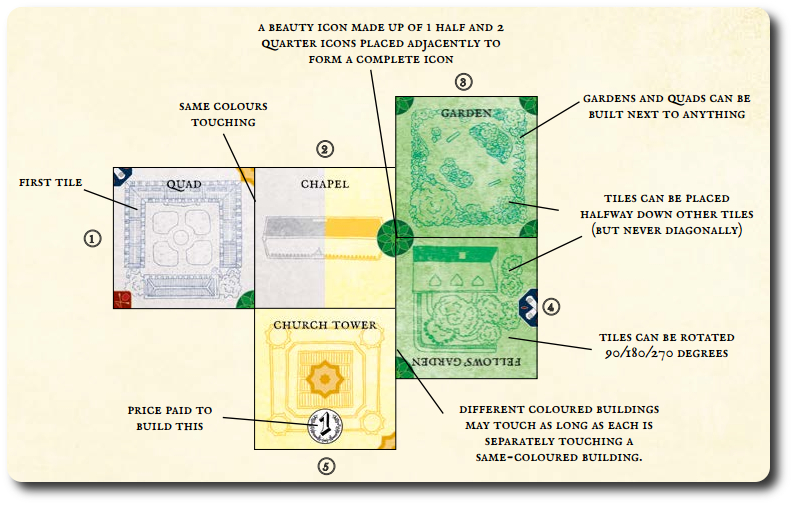
The Building tiles provide benefits that are used to attract Scholars. However, most Building tiles only provide 1/4 of the benefit (located on the Building tile’s corners). This means players will need to acquire Building tiles with specific benefits and colors to correctly build their college. There are also Building tiles that provide the benefit by default and do not need to be attached to another Building tile to complete the benefit icon. The benefits are as follows.

Note: New Building tiles are drawn AFTER the current player completes their 4 actions.
Action: Admit a Scholar
The face-up Scholar cards for the Era are available to admit to a player’s college, but they must first meet the Scholar’s requirements. Listed on the top of every Scholar card are the required benefits provided by the Building tiles. The number of total Building tiles a player has in their college is not important, but they must have enough buildings that provide the benefits listed. Each Building tile can only be used once to provide a benefit requirement. If the player meets the requirements, they can take the Scholar and place it in front of them.
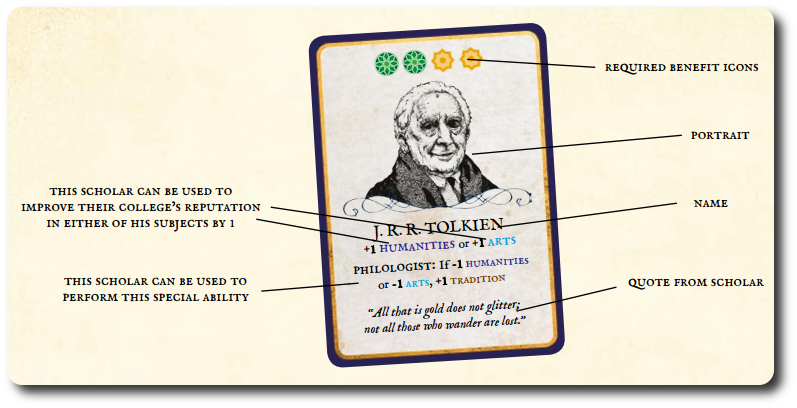
Note: New Scholar cards are drawn from the Scholar draw pile AFTER the player completes their 4 actions.
Action: Use a Scholar
A player can use any of their Scholar cards that have not yet been used in the current turn. Scholars can do one of the following, but not both.
- Increase the player’s college’s reputation
- Perform their scholarly ability
A college’s reputation is tracked on the scoreboard. If the scholar is used to improve the college’s reputation, the Scholar card will list one or more subjects and the bonus the Scholar provides. The player will need to select which subject they want to improve and then move their player cube accordingly on the scoreboard. If the player doesn’t have a cube yet on the scoreboard for the subject they want to improve, it’s now placed.
Scholarly abilities can be very powerful, but can also cost the player. Some Scholarly abilities will require the player to reduce their reputation in a subject or pay money. These abilities are neither good or bad in the short run, however. The player must determine how the Scholar’s academic influence can further their college’s reputation. Sometimes, to further one’s goals, you have to pay upfront and hope the return in the future was worth the cost.
Action: Draw 1 Random Coin
As an action, the player can draw 1 random coin from the Money bag and add it to any other coins they have collected. Remember to keep all coins hidden and secret from opponents.
Step 5: Resolve Event
The Chancellor now resolves the revealed Event, but not in the way you might think. Players bid for the Event card and its reward. More to the point, players are also bidding on who will go first during the next Era as the winner will become the new Chancellor.
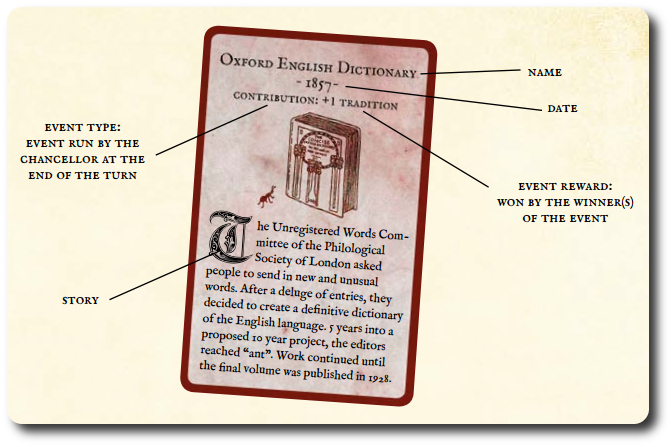
Bidding is determined by the Event type.
- Action: Chancellor opens the bid and then the bidding progresses in turn order sequence. Players must always bid higher than the last bid or pass. Players who pass can bid the next time the bidding turn order sequence returns to them. When no one bids higher than the previous bid, the player who bid the highest pays the amount using their coins and collects the Event card, as well as the Chancellor’s Mace. The Event card’s reward is then resolved.
- Silent Auction: All players place any amount of coins in their hand and keep it secret from their opponents. When ready, all players reveal their bid by opening their hand and stating how much they are offering. The player with the highest bid wins the Event cards, the Event card’s reward, and the Chancellor’s Mace.
- Dutch Auction: The Chancellor slowly counts down from 12 to 0. Any other player can shout “bid” during this countdown. The player who shouted “bid” now pays the amount in coins equal to the last number spoken by the Chancellor, collects the Event card, resolves the Event reward, and receives the Chancellor’s Mace.
- Contribution: All players place any amount of coins in their palm secretly and then reveal them when everyone is ready. The player with the first and second highest amount of coins share the Event card’s reward, but the player who bid the highest claims the Chancellor’s Mace. If players tied for first, no reward is given to the second highest bid. All players, regardless if they won or not, lose the coins they used in the bid.
Note: The Chancellor’s Mace always goes to the player who won the bid. In the event of a tie, the current Chancellor gets to determine who will get the mace by selecting one of the tied players. The rules do not state if bribes are allowed or not. I’m just saying…
Events can also be triggered by Scholarly abilities. If so, an Event card is drawn from the Event card draw pile and the player who triggered the Event runs the bid as normal. However, the winner of the bid does not claim the Chancellor’s Mace. That only happens when an Event is won at the end of a turn.
Step 6: Score Era (on second turn only)
At the end of the second turn of the Era, players now determine their score. This step is skipped during the first turn of every Era. You’ll need to refer to the following scoreboard image to understand what I’m about to describe as scoring in this game can be a bit tricky to understand at first.
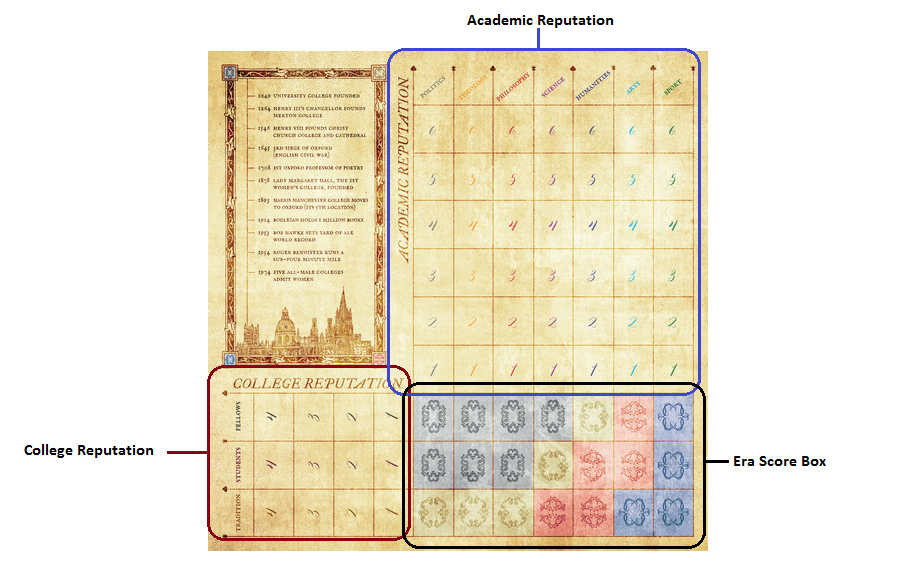
To begin with, the scoreboard has three different sections that are used and there are multiple steps to determine the Era’s score. An Era is scored as follows.
A) Determine Era Score Box Ownership
First, you will only be scoring certain College Reputation rows and Academic Reputation columns. Each Era scores differently and what is scored is indicated by the Era Score Box (my term for it – the game refers to them as “active scoring boxes”). For example, the Medieval Era will be scoring the “Fellows” and “Student” College Reputation rows and “Politics”, “Theology”, “Philosophy”, and “Science” Academic Reputation columns. To make it easy to determine which boxes in the Era Score Box are being scored, match the boxes to the current Era color. Only the current Era and previous Era boxes are scored.
Second, for each Era Score Box, determine which player has the most points by adding the numbers in the row and the column that intersects with the Era Score Box. For example, the left top-most Medieval Era Score Box scores the “Fellows” College Reputation row and “Politics” Academic Reputation column. The player who has the highest total places their cube color in that Era Score Box.
Note: Reputation cubes are NEVER removed from the scoreboard.
If there are ever ties, they are broken by first awarding the win to the player who has more points in the Academic Reputation for that specific Era Score Box. If that cannot be used, victory goes to the player with the biggest college (number of tiles). If there is still a tie, the player with the most money wins followed by the Chancellor determining who should win.
B) Eliminate Era Score Box Ownership
Count the number of Era Score Cubes each player has. The player with the least number of cubes removes their cubes from the Era Score Boxes. Ties are broken based on size of college, then money, and then by Chancellor’s decision.
Those empty Era Score Boxes must now be filled. Determine which player cube should be placed by repeating “A” above, but ignore the cube colors that match the cubes that were just removed from the Era Score Box. In this way, a player who never had a chance to win an Era Score Box might suddenly find themselves with 2 or more.
C) Repeat
Repeat “B” until there is only 1 player cube color remaining. This player has won the Era and collects 1 coin from the Money bag at random. If this was the final Era, the player who wins also wins the game.
Now here is the part that confused many of our players. As the game progresses, the cubes in the Era Score Box will continue to be added and removed. Each Era builds off the previous one. This means each scoring portion at the end of an Era will take slightly longer than the last one as the number of possible empty Era Score Boxes that need to be refilled increases. But the way you determine the winner is always the same. It just takes a bit longer each time you do it because there are more cubes to consider.
To learn more about Dreaming Spires, visit the game’s web page.
Final Word
The Child Geeks had a hard time getting into this game. All the Child Geeks demonstrated a clear understanding of how to build their college, how to use the money in auctions, use their Scholars, and make use of the Event benefits. What they kept failing to grasp was the scoring. According to one Child Geek, “I don’t understand why some players are getting points and some players aren’t. It doesn’t make any sense to me.” Another Child Geek said, “I like everything about this game except when we score points.” Not all the Child Geeks had difficulty grasping how points were earned, but the lack of a well understood means to make points was causing a great deal of frustration. Not enough to persuade all the Child Geeks to dislike the game, however, which left Dreaming Spires with a mixed approval from the Child Geeks.
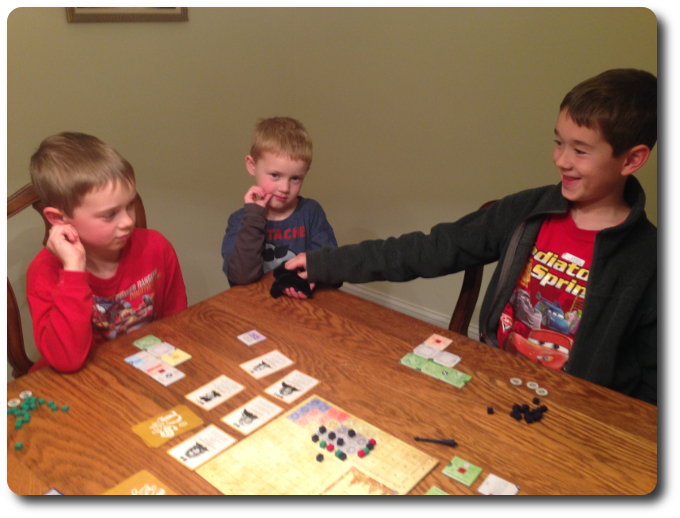
My middle child isn’t feeling the game, so his older brother gives him some words of encouragement (youngest child is bored)
The Parent Geeks also were a bit confused about the scoring, but after a brief explanation and the conclusion of an Era, the Parent Geeks understood it perfectly. One Parent Geek said, “Oh! That’s how the scoring goes. I was looking at it wrong. OK, now got it.” Well, no, not really. It took a game or two until the Parent Geeks felt truly confident in their ability to understand how to score points. According to one Parent Geek, “Wow, this game has a lot of layers. I like that and I don’t feel overwhelmed, but this game is riddled with subtle decisions and strategy.” Not so much that the casual gamers felt overwhelmed, but the non-gamers remained confused and somewhat lost at time. When the eras came to an end, all the Parent Geeks voted to approve Dreaming Spires.
The Gamer Geeks were happy to give the game a try as it looks very appealing on the gaming table. They quickly understood the game’s simple and straight forward rules and again, like the other geeks before them, came to a confused stop when it came time to score. Unlike the other groups, the Gamer Geeks were only confused for about a minute or two as I explained the scoring – again – and then they had it. According to one Gamer Geek, “I am really enjoying this game. It’s easy to learn, easy to play, and has a lot of depth to it.” Another Gamer Geek said, “At first I thought the game was a bit out of control with everything you can do, but I see now how each action fits and works together. Great game.” And finally, another Gamer Geek wanted to say, “This game feels a bit fiddly, I think it could use some tightening up, but I’m enjoying myself. Not a perfect game, but it’s a fun one.” All the Gamer Geeks voted to approve Dreaming Spires.
I was fortunate enough to speak to the Mr. Hogan, the game designer, about Dreaming Spires. I always find the origin stories of games to be interesting. According to Mr. Hogan, one of his inspirations was observing the grounds and history of the University of Oxford. Great and important thinkers walked the same paths and lectured under the same roofs Mr. Hogan now contemplated his own lessons as a student. This, as you might have guessed, inspired Mr. Hogan in a profound way.
Once I started to realize how many extraordinary stories Oxford had to offer, it struck me that as a game designer, I had the perfect medium to share them. My aim was to create an accessible but strategic experience that included Oxford’s famous people, events and colleges and while the systems in the game evolved during development, these three elements are the pillars that the game is built on. – Jeremy Hogan, Game Designer
That might very well be true, but I think the center pillar of this game is the scoreboard. Buying tiles, admitting Scholars, and purchasing Events is good fun, but why you bother to mess with these bits is unclear. That is until you put the focus on the scoreboard. It’s here that players will see how each Era influences the score that slowly creeps forward. Each Era is an opportunity to change the Era Score Box and shift the victory. That is downright awesome and terribly inconvenient if you don’t understand how scoring works. Players must constantly diversify and strengthen their academic and college reputation or they risk losing ground. This makes every tile you place important, every Scholar you admit a possible advantage, and each Event a game changer. Simply excellent.
As for me, I very much enjoyed Dreaming Spires. It hit all the right buttons and played very well. I was frustrated at times when I didn’t build my college well enough or I was outbid by an opponent for an Event, but not once did I leave a game grumpy. This is a fun game, a challenging game, and frustrating game all wrapped into a nice package. It made me think, made me despair, and made me shout for joy. Can’t ask for much more than that.
I will leave you with one last quote which the game designer found inspirational and serves as the origin of the game’s name. I think the quote does an excellent job of summing up that game, too.
“It is well that there are palaces of peace, And discipline and dreaming and desire, Lest we forget our heritage and cease The Spirit’s work – to hunger and aspire” – from Oxford, by CS Lewis
This game was given to Father Geek as a review copy. Father Geek was not paid, bribed, wined, dined, or threatened in vain hopes of influencing this review. Such is the statuesque and legendary integrity of Father Geek.



